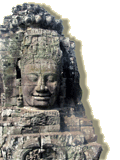
ASIA 2007 - Thailand | Nepal | Cambodia | Malaysia
 ASIA 2007 - Thailand | Nepal | Cambodia | Malaysia |

|
We thought about visiting Angkor Wat several years ago, but too many people were still being blown up by landmines. | The Killing Fields were a number of sites in Cambodia where large numbers of people were killed and buried by the Khmer Rouge communist regime which ruled the country from 1975 to 1979. Estimates range from 1.5 to 3 million who died out of a population of around 7 million. The Khmer Rouge judicial process, for minor or political crimes, began with a warning. Any person who had contact with a foreign source of any kind was charged with crimes against the government. This included having contact with a missionary, international relief organization, government agency, any kind of free market activity, etc. Any individual who received more than two warnings was sent for re-education, which meant almost certain death. Detainees were often encouraged to confess to Angkar their pre-revolutionary lifestyles and crimes and were told that Angkar would forgive them and wipe the slate clean. This meant being taken away for torture and/or execution. The
executed were buried in mass graves and some were required to dig their
own graves. In order to save ammunition the convicted were often executed
using hammers, axe handles, spades or sharpened bamboo sticks. Life in
Cambodia in the 1970s was truly hell on earth. |
||
|
|
I have enough problems with my appendages without a landmine making it worse. Clearing landmines has been a monumental effort. Several countries and agencies around the world have come in and helped Cambodia to remove this problem. |
|||
| We finally decided the time was right for a visit and we were pleasantly surprised to find Siem Reap filled with modern buildings, clean streets, and well manicured parks and parkways. The airport is new and beautiful. New luxury hotels line the road coming into town, however we chose to stay in more moderate accommodations at the Sydney Angkor Hotel. |
| We found it to be not only very affordable, but comfortable, clean, and well located. Don’t make the mistake that we made and change money into Cambodia Riels. Geeze, almost no one uses Cambodian money here. Just about all transactions were in US dollars. Even when we got money out of the ATM machine it asked if we wanted riels or US dollars. I had a wad of bills at least an inch thick (impossible to put in my wallet) from converting just $100 USD.
|
 |
Angkor Thom is an enormous highly-structured city that was built in the 12th century. The entrance to the city is through an impressive huge walled archway with gigantic stone heads everywhere. |
|
 |
Tourists are allowed to climb (at your own risk) the steep narrow steps to the top level. I was still battling a cold and a bad back and so I just sat and watched others climb to the top. Several poor soles found coming down the steps terrifying and one was in tears before she reached the bottom. I can’t just sit here! Out of the clear blue I just decided I can’t travel this far and not go to the top. It really wasn’t very difficult and the views were wonderful. I was very happy I made the climb. |
||
|
Angkor Wat is a World Heritage Site and has been nominated to be one of the New Seven Wonders of the World. The results will be announced July 7, 2007. I found the whole Angkor system to be fascinating and wouldn’t have a problem with it being on the list. However if I had a vote I would opt for the Mayan ruins of Tikal in Guatemala. There is something about Tikal’s vast size, remote jungle setting, parrots, howler monkeys, oropendola birds, and its blurred history that makes it magical and spiritual. I my opinion Tikal is a must see place.
|
|||
 |
Everywhere we traveled in Siem Reap province we saw indications of Cambodia’s horrible past and the hideous results of landmines. Almost every temple had a band of musicians made up of landmine victims playing for donations. Numerous signs along the roadways identified help groups, handicraft centers, and other relief organizations aimed at helping the multitudes of landmine victims. | |
One of the temples we visited only opened 3 years ago. Up until that time it was still to dangerous for tourists. It is heartwarming to see sign after sign of relief organizations from the US, Germany, Switzerland, France, Canada, The Netherlands, Sweden, etc. The world is here and trying to help. Unfortunately it is a little late for many of the people.
|
||